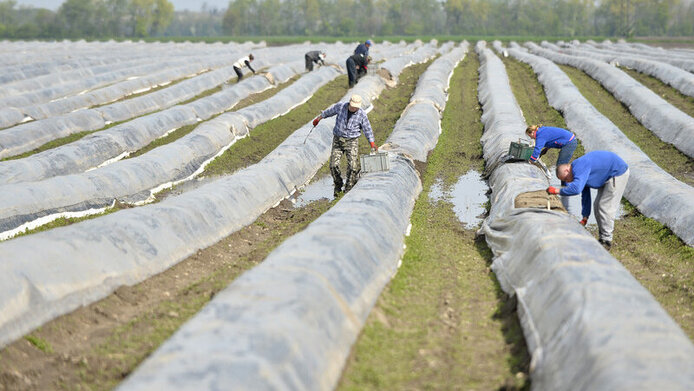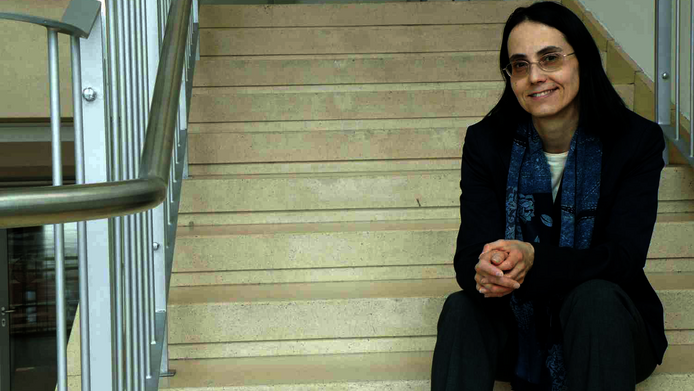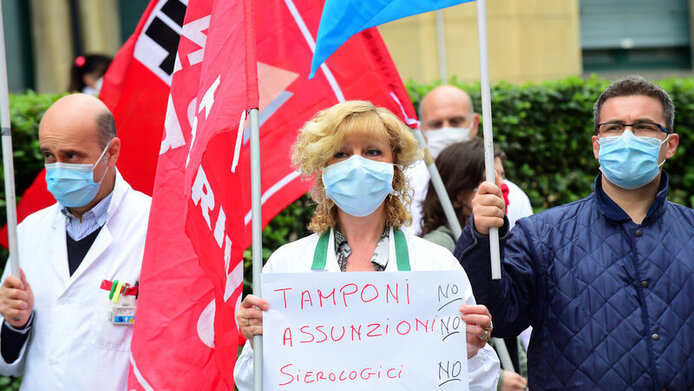“Austria has to become more self-sufficient”

Right now, the global economy is eclipsed by the corona pandemic. The spread of Covid-19 and the measures taken to contain it are triggering substantial slumps in economies throughout the world. In Austria, unemployment is at its highest level since 1945 at over 12 percent, a figure that would be much higher if one were to factor in the one third of all employees now on short-time work. As of 21 April 2020, the Vienna Institute for Advanced Studies (IHS) and the International Institute for Applied Systems Analysis (IIASA) predicted that Austria's economic output will decline by at least 6 percent for the year as a whole. According to the IHS, all current forecasts involve a downward risk, as the extent of the economic drop depends on the evolution of the pandemic as well as on economic and health policy measures taken and their impact. “We currently have deficits on both the supply and the demand sides because not only has production declined, but consumption as well. The last time we had such a constellation was during the oil price shock in the 1970s,” explains Marion Rauner, a health economist at the University of Vienna.
Second shutdown not economically feasible
Areas particularly affected include retailing, transport, accommodation, restaurants, art and culture as well as personal services such as hairdressing. The extent of the plight for many Austrian small and medium-sized enterprises (SMEs) is illustrated by a survey conducted by the Austrian Credit Protection Association (KSV) in mid-April: 30 percent of the 1,100 companies surveyed stated that their liquid assets would tide them over for just three months, while 14 percent said they would last out for only four weeks. Two thirds of the companies surveyed were hit hard in economic terms by the federal government's shutdown measures. “Economically, we will not be able to withstand a second shutdown,” warns Rauner, an expert in health and disaster management. Rauner perceives an urgent need for action on several fronts. One of them is the preservation of important measures such as hand washing, social distancing and wearing face masks in confined and enclosed spaces, although, as she points out, wearing these for too long can also be harmful to health. On a second level, the organizing of large events in confined spaces is something that one should evaluate further. And in the future, close attention should also be paid to anti-virus protection in ventilation and air conditioning systems.
Strategic Disaster Management Wiki
Rauner knows what she is talking about, as she has been dealing with epidemics and disaster control for 27 years. Between 2014 and 2017, in the context of the EU project S-Help (Securing Health.Emergengy.Learning.Planning), she worked with research groups from Ireland, Sweden, the UK and Israel to develop a computer-based disaster management organization tool for the targeted transnational, EU-wide management of dangerous events, especially floods, chemical accidents and epidemics. The project team developed a tool that can be fed with all the information that is vital in the event of a disaster: stakeholders involved, decision-makers and institutions, as well as communication structures, even including geographical and demographic data and weather forecasts. The team from the University of Vienna under Rauner’s lead developed a strategic disaster management wiki as well as a taxonomy of the different national stakeholders, the main resources required and the available EU disaster management modules with regard to the control and management of floods, chemical accidents and epidemics.
Large differences between countries
This is an extremely complex undertaking, as there are major differences between countries in how disaster response systems have developed and how countries are exposed to events in terms of their geographical and demographic structure. One reason for the high number of Covid 19 deaths in Italy, for example, is to be found in its southern European demography. “On the one hand, the Italian population is among the oldest in Europe, whilst on the other there is a higher number of large families, which means that infection rates are more extensive,” explains Rauner. “In addition, the number of in-patient hospital beds – especially intensive care beds – and the available inventory of respiratory equipment are substantially lower in Italy than in Austria or Germany,” she adds.
Disease in Israel - a déjà vu
The team tested their tool on the basis of three disaster scenarios: a flood, a chemical explosion and the outbreak of an unknown infectious disease. They fed all important data into the tool, set up communication structures using drones and programmed a tool for communication between emergency teams and the national authorities. Remembering the epidemic scenario simulated in Israel in September 2016 gives Rauner a sense of déjà vu: the scenario involved an unknown disease that had been introduced to the country by plane. The researchers from Israel and Ireland narrowed down the cases, informed the media and fed all relevant information and resources such as hospitals, intensive care bed capacities, schools, etc. into the tool. “When I was sitting in the bunker of the Israeli emergency organization at the time, I never thought that this situation would actually occur barely four years later,” Rauner recalls.
First response
The first measures for containing a pandemic foreseen by the strategic disaster management wiki are: educating the population in a way that doesn’t provoke panic, taking necessary evacuation measures, ensuring supplies for the population, communicating hygiene measures, identifying the national and international stakeholders involved and the main resources needed by them, wearing protective masks and closing schools and kindergartens. These are precisely the measures implemented by most European governments in the fight against Covid-19.
Hazards of large-scale events
Rauner assesses the Austrian government's performance positively, but would have liked to have seen some measures taken earlier. “I already knew in January that something bad was heading our way because I had closely followed the SARS epidemic in 2002/2003,” she says. When it comes to infectious diseases, Rauner sees the greatest danger in large events or crowded rooms such as discos and bars, where numerous people are concentrated in a confined space. In Ischgl – the Austrian corona hot-spot – many winter sports tourists were infected at après-ski parties and carried the virus back to their home countries. Rauner remembers the SARS epidemic in 2002 when a single infected individual in Asia infected about 17 guests at a hotel, which then resulted in a SARS hotspot with a few hundred patients in Canada caused by an infected tourist returning home from that hotel. In Germany, the data also show that Covid-19 broke out in places where carnival events took place. "The Venice Carnival, the Villach Carnival, all these events should have been cancelled,” Rauner says with great conviction.
Why Covid-19 is so dangerous
It is these events, which epidemiologists call “superspreaders”, that contribute extraordinarily to the spread of a pandemic. Specific characteristics of the Covid 19 virus make it so dangerous: there are many asymptomatic carriers - i.e. people who were infected without showing symptoms – and most probably even an acute phase with high infectivity and also a so-called window phase, during which tests do not detect the virus. “If two or even three of these things coincide, you can end up with a superspreading event where a lot of people are infected very quickly,” explains Rauner. In addition, the corona reproduction rates were initially two and a half days, which means that the number of people infected doubled every two and a half days, leading to an exponential increase in infections. “At such a high infection rate, every single day that passes without action being taken is fatal,” Rauner emphasizes. In Italy one could observe what this means. The Italian healthcare system was on the verge of collapse: there was a lack of intensive care beds and respirators, a lack of disposable materials and protective clothing for hospital staff. Everyone still vividly remembers seeing the pictures of desperate doctors from Lombardy in all the media.
Lack of personal protective equipment
“Italy was taken by surprise. We had been warned and knew that we were about nine days behind Italy in epidemiological terms and that we would have to act quickly to flatten the curve,” says Rauner recalling the time in mid-March when Austria went into lockdown. In Austria too, doctors in private practice and hospital staff complained of a lack of personal protective equipment and disposable items. In addition to production bottlenecks, Rauner also noted a lack of awareness. “No-one was really alert to the need of having a big enough stock of disposable items – not even doctors.”
Disposable items not classified as important
She first noticed this effect in 2000/2001, when she conducted a study with students on strategic technology management in Viennese hospitals. She asked Austrian hospitals how important they considered disposable items such as syringes and gloves to be. The answer at the time was "not important". In a second survey about ten years later, these things were already considered more important, but there was still a lack of awareness of the need for sufficient stocks. Rauner considers this to be a clear omission in strategic terms.
Vulnerability in the globalised economy
There was a scarcity of personal protective equipment throughout Europe because most of the disposable items are produced in China. The Corona crisis clearly shows the vulnerable aspects of an economy based on globalisation and just-in-time production. A case in point is the fact that the first palpable impact of the containment measures and border closures in Austria was a shortage of agricultural workers and nursing staff providing 24-hour homecare. When the asparagus was ready for picking in mid-March, there was a shortage of field workers from Eastern Europe. Strawberry farmers are now anxious to see whether their foreign helpers will be able to come in on time – or whether they will have to watch their fruit rot in the fields.
Self-sufficiency in demand again
What are the lessons for the future to be learned from these experiences? “Agriculture, disposable items, oxygen equipment, disinfectants – these are very central strategic aspects. We have to regain self-sufficiency in these fields,” says Rauner. “We are a land of wine and schnapps. Every liquor producer has distillation equipment and can produce disinfectants,” she observes, quoting a simple example. She herself also has a small distilling apparatus at home. As an economist she makes the plea for more flexibility and pragmatism. An Austrian shirt manufacturer, for instance, has converted parts of its production line to making protective masks. Oxygen equipment could also be produced by domestic companies. “In the UK, a lawnmower manufacturer now produces pumps for ventilators,” Rauner mentions. She also cites the example of two Austrian companies from different industries who have bundled their expertise to produce high-quality face masks.
Renaissance of agriculture
As far as agriculture is concerned, the 50-year-old health economist sees the need for a complete change of perspective: "We need to get back to valuing food more highly and paying more for it. We have to go back to a more sustainable way of life.” According to Rauner, more Austrian workers are needed in the agricultural and long-term care sectors. She reckons that the tourism industry, which was badly affected by the corona crisis, will have to restructure itself – which will lead to further job losses. “People have to be flexible and work in agriculture or in care,” she says and is quite positive about the development. “We will see a renaissance of agriculture as well as a reappraisal of volunteer activities.”
Bringing medical production closer
When it comes to medical products, it will be more difficult to adapt production because many elements come from China or are largely produced in India. Rauner feels there is a lesson to be learned from the corona crisis and production must be brought closer to home. “It makes a difference whether drugs come in a few hours by truck or rail from the Czech Republic, for example, or in a few hours by ship from riparian countries on the Danube, or whether you have to wait more than six weeks for a container coming from China.” She also thinks we need to get away from just-in-time production. When the lock-down began in China, Austrian companies ran short of materials that are produced there. In addition, it became clear that Austrian SMEs need to boost stocks in their warehouses. As a positive example, Rauner quotes a small electrical retailer close to her home in Lower Austria, who had stockpiled 300 vacuum cleaners and other household appliances on her advice. “During the shutdown, he was one of the few shopkeepers in the area who was able to do online business. The others soon ran out of stock.”
"Creative power of destruction"
Rauner notes that there are many examples of economically challenging times to be found in history. At the beginning of the First Republic, for example, Austria had shrunk from a dual monarchy of around 52 million people to a republic with just 6 million inhabitants. “The grain supplies from Hungary were lost, whilst the railway capacity was too big for the little that remained of Austria. The adjustment took a few years. But if everyone makes an effort in a spirit of solidarity, we will manage it,” asserts Marion Rauner. It was the Austrian national economist Joseph Schumpeter who coined the dictum of the “creative power of destruction”.
It may take two years
Expecting further waves of disease, Rauner counsels preparing for them and following some key measures. “We have to be prepared for at least two years where things will be different; we have to take long-term measures and we must not relax them too quickly, because we don't know yet how this disease will develop in epidemiological terms."
Key measures for the next two years
Rauner sees the wearing of face masks as one of these key measures. She pleads for a well thought-out obligation to wear masks at all times in confined and enclosed public spaces, such as lifts or administrative offices, and not only in shops and public transport – and this includes the proper handling of masks, i.e. washing and changing them. “You don't own just one pair of underpants either,” she says with a laugh. Rauner also deems it necessary to keep indoor swimming pools, indoor fitness centres and, perhaps, cinemas closed – “possible outbreak sites”, as she calls them. The scientist is also very concerned to see many people returning to their offices: “Air conditioning and ventilation systems are a massive potential risk and most of them have no virus filters.” This is why she is in favour of working from home wherever possible. There should not be any large-scale events for a long time to come to prevent a second pandemic. Likewise, travel restrictions should be maintained - especially on trains and airplanes, given the hazards of air conditioning and confined spaces.
Challenges ahead for tourism and air transport
Rauner thinks tourism and air transport are areas which will be hard put to adjust. “You can't catch up on consumption in tourism, because you can’t double book hotel rooms and the airlines already need massive financial support. Many of them would not survive a second wave. “But we do need minimum capacities, otherwise we will no longer have an airline and hotel industry,” she warns.
Interdisciplinary centres
During the weeks of lockdown and isolation, it also became clear that the economically vital spheres that absolutely must be preserved include not only nutrition and health, but also psychological care. As a recent study by the Danube University Krems shows, the lockdowns have a noticeable effect on mental health. A case in point: the incidence of depressive symptoms among the population has multiplied from about four to more than 20 percent. “Burnout, cabin fever and an increase in cases of domestic violence are three phenomena researchers have observed,” says Rauner, who is also trained in pastoral care in hospitals. Her vision is to establish interdisciplinary centres together with experts in psychology and theology as well as in sports and nutrition science.
Strategic foresight and solidarity
Comprehensive and strategic foresight – which this professor of public and non-profit management sees as central to the economy – is something she would like to convey to her students. “They should have a good overview at the strategic level of the important fields of the environment, education, sport and energy, as well as health and disaster management.” The current crisis is a good yardstick for the importance of such foresight, but it also illustrates the significance of solidarity. “We must all give our best at this time. If everyone manages to lend support to just one or two people annually, we will turn the situation around in a few years,” runs Rauner’s plea for solidarity.
Personal details
Marion Rauner is Associate Professor at the Faculty of Business, Economics, and Statistics at the University of Vienna, which she joined in 1991. She received an MBA in Business Informatics, a Ph.D. in Social and Economic Sciences, and her professorial qualification in Business Administration. Her research interests include disaster management, health care management, innovation and technology assessment as well as public and non-profit management. Between 2014 and 2017, Rauner collaborated with international partners in the EU-funded S-Help project to develop a disaster support tool designed to help governments in the strategic management of disasters such as floods, chemical accidents or epidemics. Her share involved a strategic disaster wiki, taxonomies of disaster management stakeholders and the main resources needed by them. Rauner has been studying epidemics for almost three decades. In the academic year 1999/2000, she was awarded an Erwin Schrödinger fellowship by the Austrian Science Fund FWF to conduct research on the HIV/AIDS epidemic in Stanford together with Margaret Brandeau there and to widen her education in the field of health economics decision modelling as well as engage in international networking.







